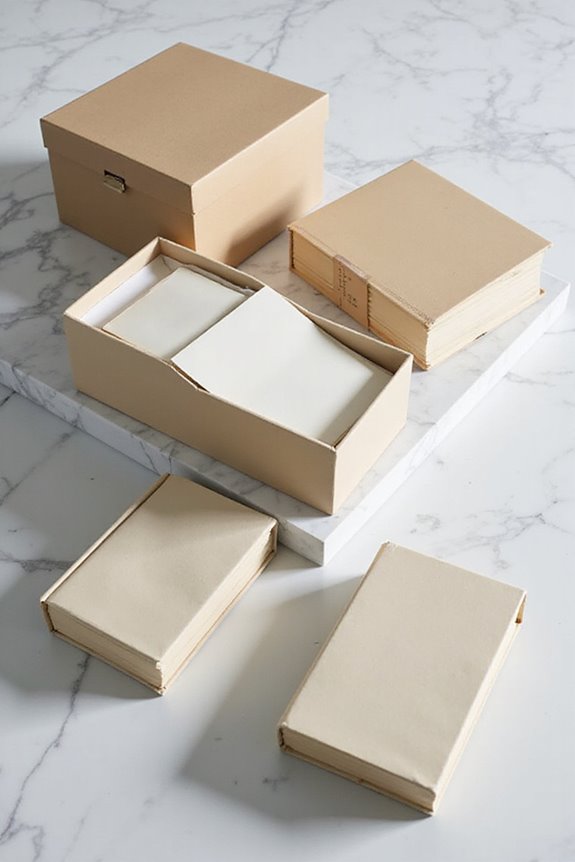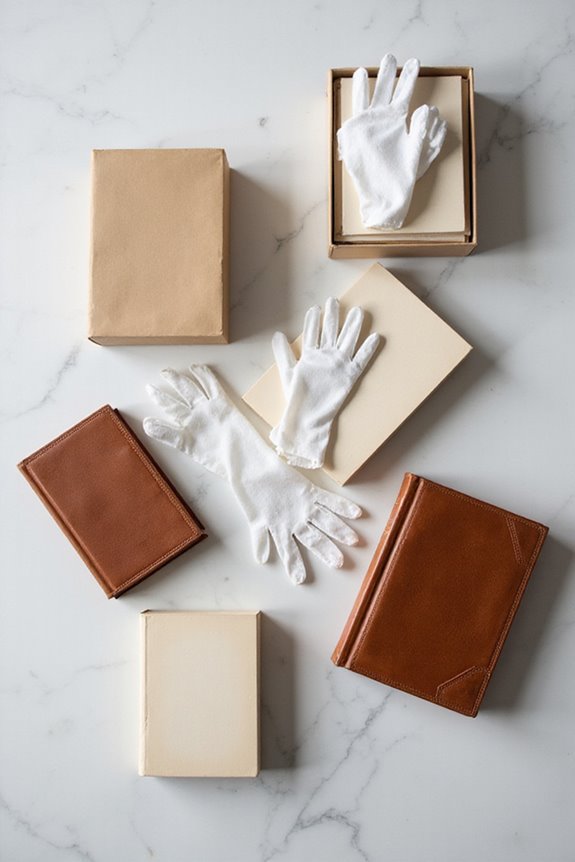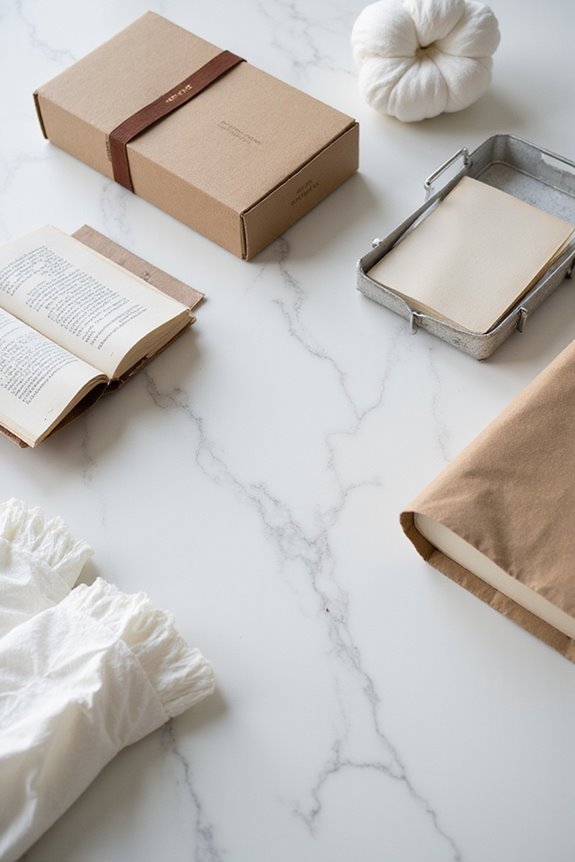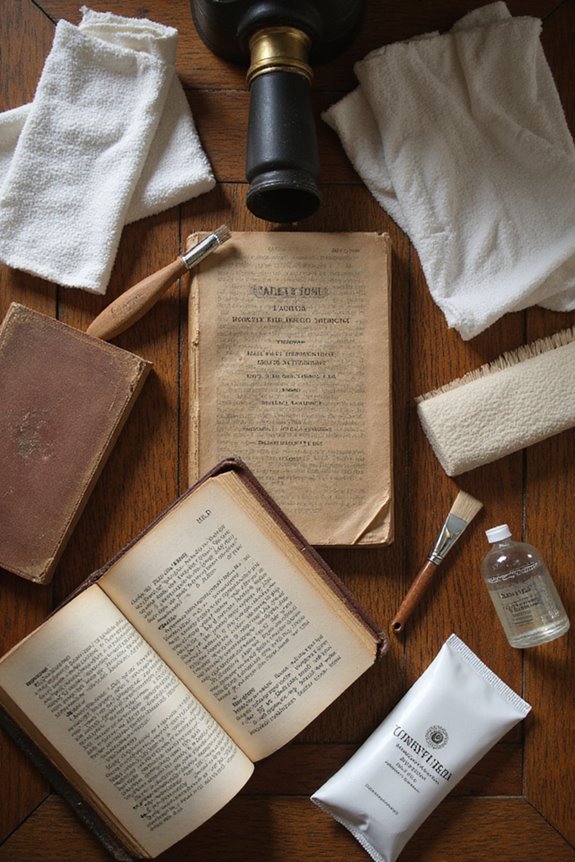When we talk about archival materials for book storage, we’re referring to specialized supplies that keep our precious collections safe and sound. This includes acid-free boxes, like Hollinger boxes for papers, and sturdy metal edge boxes for rare finds. We should store books upright or flat, controlling temperature and humidity, while wrapping fragile ones in acid-free materials. Using archival-quality plastic sleeves can protect against dust and wear. Stick around, and we’ll share even more tips on keeping your books in tip-top condition!
Key Takeaways
- Archival materials include acid-free boxes and paper that protect books from environmental damage and degradation over time.
- Metal edge boxes and acid-free corrugated boxes suit different storage needs based on item rarity and usage frequency.
- Properly wrapped fragile volumes in acid-free materials add an extra layer of protection against wear and damage.
- High-quality polyethylene and archival-quality plastics, like polyester sleeves, safeguard items from dust and minimizing deterioration.
- Maintaining stable environmental conditions and using safe materials ensures optimal long-term preservation of books.
Importance of Archival Materials

When we think about the importance of archival materials, we might realize that they’re like the unsung heroes of book preservation. These materials play a vital role in cultural preservation and ensuring knowledge continuity. By extending the physical lifespan of books, they help bridge the gap across generations. For instance, using acid-free, chemically inert products protects against environmental damage, so our rare texts stay readable for studies and casual browsing alike. Plus, secure archival storage keeps books safe from pests and moisture. When institutions invest in effective storage solutions, they affirm their commitment to keeping history alive and accessible. This isn’t just about pages and ink; it’s about safeguarding our shared legacy. So, let’s embrace the art of preservation!
Types of Archival Boxes

Choosing the right type of archival box is essential for preserving our treasured books and documents. First, let’s consider metal edge boxes; they’re super sturdy and great for rare items. Then, we’ve got acid-free corrugated boxes that protect against degradation—perfect for everyday use! Don’t forget Hollinger boxes, which are ideal for storing loose papers. For more specialized needs, think about SafeColor® or SafeCote® boxes, especially if you’re dealing with high-use collections. For unique items like textiles or photos, specialty boxes are a must. Remember, proper box selection not only safeguards your items but also enhances your storage organization. So, take the time to choose wisely, and your collection will thank you!
Protective Storage Practices for Books

To guarantee our books are well-protected, we should consider a few key storage practices that make all the difference. First, let’s control the environment. Keeping temperatures around 65°F to 70°F and humidity between 40% and 55% are essential preventative measures. We can use dehumidifiers and hygrometers to monitor these levels closely. When it comes to positioning, many books should be stored upright with sufficient support, while larger ones should lay flat. Plus, wrapping fragile volumes in acid-free materials acts as a smart storage solution. Finally, let’s keep pests at bay by regularly cleaning our storage areas and avoiding food nearby. By following these practices, we’ll guarantee our beloved books stay in great shape for years to come!
Supportive Storage Accessories

Supportive storage accessories play an essential role in preserving our beloved books, making them easy to access and keep in prime condition. For instance, utilizing archival labels allows us to implement effective labeling strategies that help organize our collections without damaging the surfaces of our books. We can create clear, concise labels that guarantee we understand exactly where everything is stored. Additionally, handling tools like rulers and paper trimmers come in handy for precise preparation and conservation tasks. We can also consider using weights and press boards to maintain flat storage, preventing our books from warping over time. With these accessories, we not only protect our books but also streamline our storage system, making it user-friendly and efficient.
Features for Handling and Transport

Handling and transporting books isn’t just about moving them from point A to point B; it’s a careful process that can mean the difference between a well-preserved volume and a damaged one. We need to follow transport guidelines that emphasize protection. For instance, using acid-free tissue or wrapping paper prevents abrasions during transit. Employing supportive enclosures helps, too; custom boxes for heavy volumes can minimize stress on bindings.
When handling, let’s remember to support a book’s spine and cover properly. One book at a time is the way to go—no juggling acts allowed! Finally, keeping everything organized with clear labels simplifies our lives and protects our cherished volumes. Happy transporting!
Material Standards and Safety Compliance
When we think about the safety of our precious archival materials, understanding the right material standards is crucial. We need to guarantee that our storage solutions comply with specific material specifications and safety regulations. For instance, using durable, acid-free, and pH-neutral materials helps protect our items from chemical degradation. When selecting boxes or folders, let’s opt for high-quality polyethylene that meets archival standards. It’s also critical to follow fire safety codes; sturdy shelving that supports weight without risk is a must. Regular monitoring and maintaining proper humidity and temperature can go a long way in safeguarding our materials. So, let’s make informed choices when it comes to storage — after all, our collections deserve the best protection possible!
Acid-Free and Lignin-Free Considerations
To guarantee our archival materials stand the test of time, we need to pay close attention to the concepts of acidity and lignin. When we choose acid-free products, we’re ensuring our papers have a neutral pH, preventing deterioration like brittleness and yellowing. Plus, acid-free certification means we’re selecting material designed for longevity.
On the flip side, avoiding lignin is essential too—it’s a natural wood polymer causing acids to form as it breaks down. Embracing lignin-free benefits, like using cotton-based papers, helps keep our stored items safe from rapid decay. So, whether it’s archival boxes or sleeves, let’s opt for acid-free and lignin-free materials, protecting our books from both acid transfer and eventual disintegration.
Benefits of Using Archival Paper and Plastics
After we’ve covered the importance of acid-free and lignin-free materials, it’s time to look at why archival paper and plastics are game-changers for storage. Using these materials in our preservation strategies helps keep our books and documents safe by preventing deterioration over time. For instance, archival-quality plastics like polyester sleeves protect sensitive items from dust while letting us see them clearly—no more guesswork! Plus, these materials cushion our fragile volumes, minimizing wear during handling. They also help stabilize environmental conditions, reducing the risk of damage from humidity and temperature changes. Ultimately, investing in archival paper and plastics not only extends the life of our collections but also positively impacts the environment by reducing waste and restoration needs.
Storage Techniques for Oversized and Fragile Volumes
While we often focus on standard-sized books when discussing storage techniques, oversized and fragile volumes deserve our attention, too. For oversized volumes, we should store them flat to prevent warping, placing no more than two or three on top of each other for easy access. If our fragile bindings are a concern, using preservation-quality boxes can help protect against damage. Let’s remember to label items clearly to keep track of them without excessive handling. For very large paper artifacts, laying them flat in archival boxes is key. Rolling should be a last resort, and always done on acid-free tubes. By following these tips, we can preserve our precious oversized and fragile volumes effectively!
Frequently Asked Questions
How Do I Choose the Right Size Archival Box?
Choosing the right archival box size is essential yet straightforward. We’ll balance box dimensions with our books’ size guidelines, ensuring they fit snugly without folding. Accurate measurements make preservation effortless and safe for future generations.
Can Archival Materials Be Reused for Multiple Storage Projects?
Absolutely, archival materials can be reused for multiple storage projects. The reusability benefits enhance our storage efficiency, allowing us to protect our items effectively while minimizing waste and maximizing the life of our archival supplies.
What Is the Longevity of Archival Materials in Storage Conditions?
We acknowledge concerns about storage conditions impacting longevity factors. However, by controlling temperature, humidity, and light, we can guarantee archival materials remain in ideal condition, lasting decades or even centuries with careful preservation techniques.
Are There Environmentally Friendly Options for Archival Storage?
Absolutely, there’re biodegradable options and sustainable materials for archival storage. By choosing acid-free papers and recycled-content boards, we can preserve our collections responsibly while minimizing environmental impact. It’s all about making thoughtful choices!
How Can I Tell if My Items Need Special Archival Storage?
As we inspect our treasured items, we notice signs of deterioration: brittle edges and faded colors. By applying preservation techniques, we can guarantee these valuable pieces endure, safeguarding their stories for future generations.






